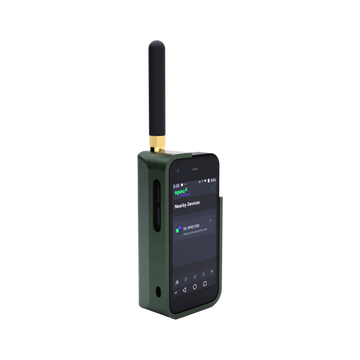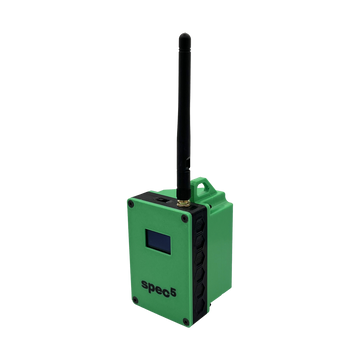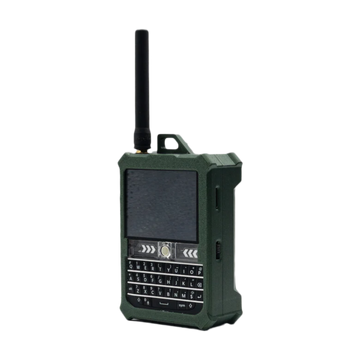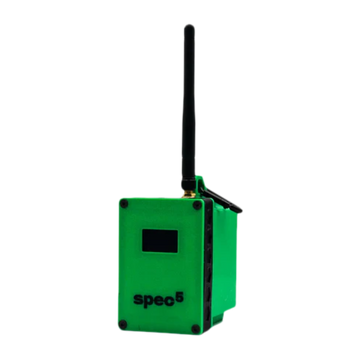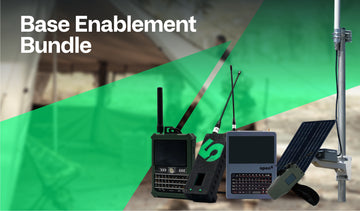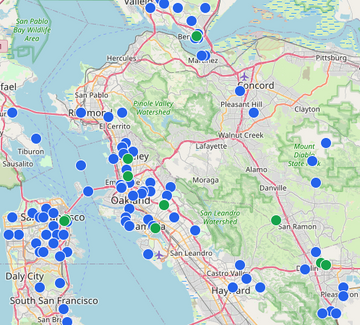Executive Summary
In today's rapidly evolving operational landscape, the ability to establish robust communication networks quickly and reliably can mean the difference between success and failure. Traditional telecommunication infrastructure often falls short in scenarios requiring rapid deployment, flexibility, and guaranteed uptime. This whitepaper demonstrates how SpecFive's innovative mesh networking solutions, particularly the Trekker Bravo and Ranger devices, enable organizations to deploy and scale secure communication networks from zero to 1,000 nodes in under an hour.
Through advanced mesh networking technology and thoughtful design, SpecFive has developed a solution that addresses the critical communication needs of emergency response teams, military operations, and large-scale event management. Our products offer unparalleled scalability, reliability, and ease of deployment, ensuring that teams can maintain vital communications even in the most challenging environments.
We invite decision-makers to explore how SpecFive's mesh networking solutions can transform their organization's communication capabilities and provide the foundation for successful operations in any scenario.
Introduction
The modern operational environment demands communication systems that can function independently of traditional infrastructure. Whether responding to natural disasters, coordinating military operations, or managing large-scale events, organizations need networks that can be deployed rapidly and scale efficiently. Yet traditional telecommunications infrastructure presents significant limitations: it's vulnerable to disruption, expensive to deploy, and often unavailable in critical scenarios.
This whitepaper demonstrates how SpecFive's innovative approach to mesh networking overcomes these challenges, enabling organizations to establish robust communication networks quickly and efficiently. We will explore the technical architecture behind our solutions, detail real-world deployment strategies, and present concrete performance metrics that validate our capabilities.
Challenges in Rapid Mesh Network Deployment
Organizations operating in critical environments face several significant challenges when attempting to establish reliable communication networks:
Infrastructure Dependency: Traditional communication systems rely heavily on existing infrastructure, making them vulnerable to disruption during emergencies or in remote locations. When cell towers fail or internet connectivity is unavailable, operations can grind to a halt.
Deployment Time: Setting up conventional communication networks typically requires extensive planning, specialized expertise, and significant time investment. In crisis situations, this delay can have severe consequences.
Scalability Limitations: Many existing solutions struggle to scale beyond a few dozen nodes without experiencing degraded performance or requiring complex configuration changes. This limitation severely restricts operational capability and flexibility.
Cost Constraints: Traditional communication infrastructure requires substantial investment in hardware, installation, and ongoing maintenance. These costs can be prohibitive, especially for organizations needing to cover large areas or multiple locations.
SpecFive's Instant-On Mesh Networking Solutions
SpecFive has developed two groundbreaking products that address these challenges head-on: the Trekker Bravo and the Ranger. These devices represent the culmination of extensive research and development in mesh networking technology, offering unparalleled capabilities for rapid deployment and scalability.
Trekker Bravo
The Trekker Bravo serves as the backbone of large-scale mesh networks, offering exceptional range and reliability. Key features include:
Long-Range Communication: Advanced radio technology enables communication over distances exceeding traditional mesh networking solutions, making it ideal for covering large operational areas.
Robust Construction: Built to military specifications, the Trekker Bravo withstands harsh environmental conditions, ensuring reliable operation in any scenario.
Intelligent Routing: Sophisticated algorithms automatically optimize network topology, ensuring efficient data transmission across the mesh network.
Ranger
The Ranger complements the Trekker Bravo by providing flexible deployment options in a compact form factor:
Portable Design: Lightweight and compact construction allows for easy carrying and rapid deployment by individual team members.
Quick Integration: Zero-configuration setup enables immediate integration into existing mesh networks, reducing deployment time and complexity.
Extended Battery Life: Advanced power management ensures sustained operation during extended missions or events.
Technical Architecture
SpecFive's mesh networking solution employs a sophisticated technical architecture that enables rapid scaling while maintaining network performance and reliability:
Network Topology: The system utilizes a dynamic mesh topology where each node can act as both a client and a relay. This design eliminates single points of failure and enables the network to self-heal when nodes are added or removed.
Bandwidth Management: Intelligent traffic shaping and quality of service controls prevent network congestion while prioritizing critical communications.
Deployment Strategy
Scaling to 1,000 nodes within an hour requires a well-planned deployment strategy. SpecFive's solution makes this possible through several key innovations:
-
Initial Network Establishment
- Deploy primary Trekker Bravo units at strategic locations to establish the network backbone
- Automatic neighbor discovery begins immediately upon power-up
- No manual configuration required
-
Network Expansion
- Additional nodes automatically integrate into the existing network
- Real-time topology optimization ensures efficient routing
- Built-in load balancing prevents network bottlenecks
-
Network
Management
-
Leverage open-source dashboards for centralized monitoring
and real-time visibility
-
Automated health checks ensure optimal performance
-
Self-healing capabilities maintain network integrity
-
Leverage open-source dashboards for centralized monitoring
and real-time visibility
Use Cases
Emergency Response
During natural disasters, SpecFive's solutions enable first responders to establish reliable communication networks rapidly:
- Command centers can deploy SpecFive Relay devices to create a resilient backbone network
- Individual response teams carry Ranger devices for constant connectivity
- Real-time situation updates and resource coordination become possible even when traditional infrastructure fails
Military Operations
Military deployments benefit
from the secure, reliable communication capabilities of our mesh
network:
-
Rapid network establishment in forward operating bases
-
Secure tactical communications across large areas
- Integration with existing military systems through ATAK compatibility
Large-Scale Events
Event organizers can ensure seamless communication across vast venues:
- Quick deployment for temporary events
- Scalable coverage for crowds of any size
- Real-time coordination between security, medical, and event staff
Integration and Compatibility
SpecFive's products are designed for seamless integration with existing systems:
Meshtastic Compatibility: Full support for the Meshtastic protocol enables interoperability with a wide range of devices and applications.
ATAK Integration: Native support for the Team Awareness Kit ensures smooth integration with military and emergency response systems.
Security Features:
- End-to-end encryption for all communications
- Role-based access control
- Secure key management and distribution
- Meshtastic Admin Mode: Allows an admin device to send commands over the mesh to change settings on specific devices or groups within the network
Performance Metrics
Our solutions demonstrate superior performance across key metrics:
Network Scalability:
- 0 to 1,000 nodes in under 60 minutes
- Linear scaling with minimal performance degradation
-
Automatic load balancing and routing optimization
Latency:
- Average end-to-end latency < 100ms
- Consistent performance even at scale
- Prioritization of critical communications
Reliability:
- 99.99% uptime in field testing
- Automatic fault recovery
- Redundant routing paths
Conclusion
SpecFive's mesh networking solutions represent a paradigm shift in rapid deployment communication systems. By combining innovative hardware design with sophisticated networking technology, we enable organizations to establish robust communication networks quickly and efficiently.
Our commitment to continuous innovation ensures that our products will continue to evolve and meet the changing needs of our customers. The ability to scale from zero to 1,000 nodes in under an hour is just the beginning of what's possible with SpecFive's technology.
We invite you to contact SpecFive to learn more about how our solutions can transform your organization's communication capabilities and ensure success in your most critical operations.
Technical Specifications
Trekker Bravo
- Range: Up to 300 meters per hop
- Battery life: 48+ hours continuous operation
- Environmental rating: IP67
- Operating temperature: -20°C to +60°C
- Encryption: AES-256
Ranger
- Range: Up to 100 meters per hop
- Battery life: 24+ hours continuous operation
- Weight: 200g
- Dimensions: 10cm x 5cm x 2cm
- Encryption: AES-256
Glossary
Mesh Network: A network topology where each node relays data for the network, cooperating in the distribution of data.
Node: Any device in the mesh network capable of sending, receiving, and relaying data.
ATAK: Android Team Awareness Kit, a geospatial mapping engine that enables coordination between team members.
Meshtastic: An open-source mesh networking protocol designed for long-range communication.
Latency: The time delay between the transmission and reception of data across the network.
Throughput: The amount of data that can be transmitted across the network in a given time period.

